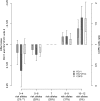Effect of five genetic variants associated with lung function on the risk of chronic obstructive lung disease, and their joint effects on lung function
- PMID: 21965014
- PMCID: PMC3398416
- DOI: 10.1164/rccm.201102-0192OC
Effect of five genetic variants associated with lung function on the risk of chronic obstructive lung disease, and their joint effects on lung function
Abstract
Rationale: Genomic loci are associated with FEV1 or the ratio of FEV1 to FVC in population samples, but their association with chronic obstructive pulmonary disease (COPD) has not yet been proven, nor have their combined effects on lung function and COPD been studied.
Objectives: To test association with COPD of variants at five loci (TNS1, GSTCD, HTR4, AGER, and THSD4) and to evaluate joint effects on lung function and COPD of these single-nucleotide polymorphisms (SNPs), and variants at the previously reported locus near HHIP.
Methods: By sampling from 12 population-based studies (n = 31,422), we obtained genotype data on 3,284 COPD case subjects and 17,538 control subjects for sentinel SNPs in TNS1, GSTCD, HTR4, AGER, and THSD4. In 24,648 individuals (including 2,890 COPD case subjects and 13,862 control subjects), we additionally obtained genotypes for rs12504628 near HHIP. Each allele associated with lung function decline at these six SNPs contributed to a risk score. We studied the association of the risk score to lung function and COPD.
Measurements and main results: Association with COPD was significant for three loci (TNS1, GSTCD, and HTR4) and the previously reported HHIP locus, and suggestive and directionally consistent for AGER and TSHD4. Compared with the baseline group (7 risk alleles), carrying 10-12 risk alleles was associated with a reduction in FEV1 (β = -72.21 ml, P = 3.90 × 10(-4)) and FEV1/FVC (β = -1.53%, P = 6.35 × 10(-6)), and with COPD (odds ratio = 1.63, P = 1.46 × 10(-5)).
Conclusions: Variants in TNS1, GSTCD, and HTR4 are associated with COPD. Our highest risk score category was associated with a 1.6-fold higher COPD risk than the population average score.
Figures




Comment in
-
Joint effect of single-nucleotide polymorphisms and smoking exposure in chronic obstructive pulmonary disease risk.Am J Respir Crit Care Med. 2012 Mar 15;185(6):683; author reply 683-4. doi: 10.1164/ajrccm.185.6.683. Am J Respir Crit Care Med. 2012. PMID: 22422905 No abstract available.
References
-
- World Health Organization Global surveillance, prevention and control of chronic respiratory diseases: a comprehensive approach, 2007. Available from: http://www.who.int/gard/publications/GARD_Manual/en/index.html
-
- Lopez AD, Shibuya K, Rao C, Mathers CD, Hansell AL, Held LS, Schmid V, Buist S. Chronic obstructive pulmonary disease: current burden and future projections. Eur Respir J 2006;27:397–412 - PubMed
-
- Weiss ST. Lung function and airway diseases. Nat Genet 2010;42:14–16 - PubMed
Publication types
MeSH terms
Substances
Grants and funding
- G0600705/MRC_/Medical Research Council/United Kingdom
- G1000758/MRC_/Medical Research Council/United Kingdom
- DH_/Department of Health/United Kingdom
- RG/08/013/25942/BHF_/British Heart Foundation/United Kingdom
- MC_UP_A620_1014/MRC_/Medical Research Council/United Kingdom
- MC_U106179471/MRC_/Medical Research Council/United Kingdom
- PG/06/154/22043/BHF_/British Heart Foundation/United Kingdom
- MC_U123092720/MRC_/Medical Research Council/United Kingdom
- G0701863/MRC_/Medical Research Council/United Kingdom
- FS05/125/BHF_/British Heart Foundation/United Kingdom
- MC_U106188470/MRC_/Medical Research Council/United Kingdom
- CRUK_/Cancer Research UK/United Kingdom
- PG/97012/BHF_/British Heart Foundation/United Kingdom
- CZD/16/6/2/CSO_/Chief Scientist Office/United Kingdom
- G0801056/MRC_/Medical Research Council/United Kingdom
- MC_U123092721/MRC_/Medical Research Council/United Kingdom
- G1000861/MRC_/Medical Research Council/United Kingdom
- 090532/WT_/Wellcome Trust/United Kingdom
- 077016/Z/05/Z/WT_/Wellcome Trust/United Kingdom
LinkOut - more resources
Full Text Sources
Medical
Molecular Biology Databases

